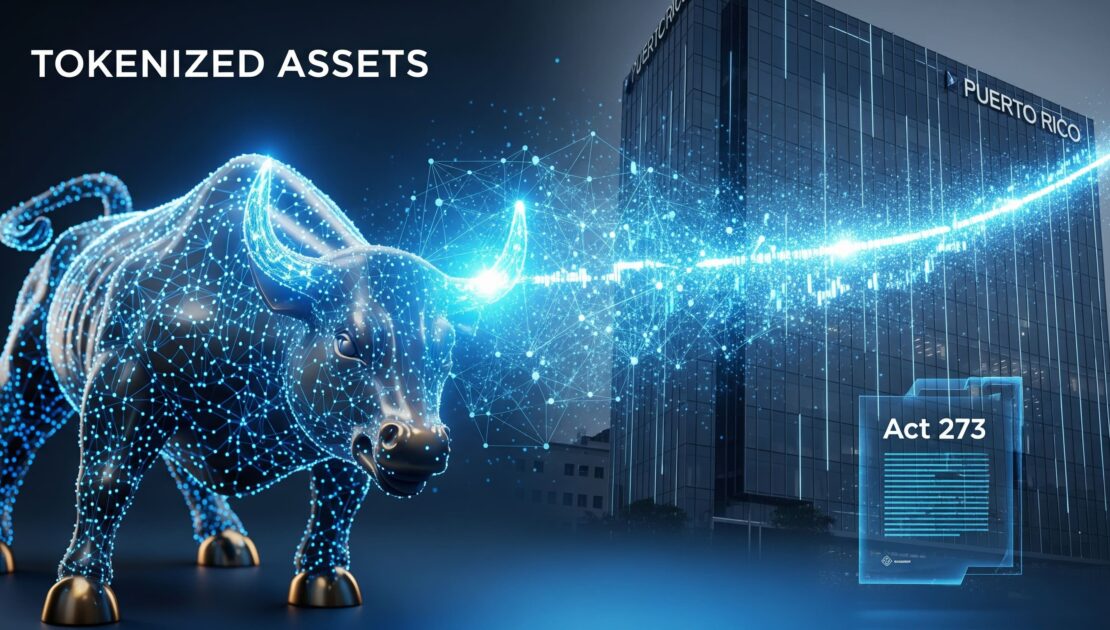Tokenized Assets Surge: Wall Street’s Dive into On-Chain Finance and Opportunities for Puerto Rico’s International Banks Under Act 273

In the rapidly evolving landscape of financial technology, the tokenization of real-world assets (RWAs) has emerged as a transformative force, bridging traditional finance with blockchain innovation. A recent report highlights how tokenized assets have doubled in value within a single year, driven largely by Wall Street’s aggressive push into on-chain finance. This development not only signals a maturation of digital asset markets but also presents unique opportunities for international financial institutions, particularly those operating under Puerto Rico’s Act 273. As a U.S. territory, Puerto Rico offers a regulatory framework that allows banks to custody digital assets, accept both U.S. and non-U.S. deposits, and benefit from a favorable 4% tax rate—making it an ideal hub for institutions looking to capitalize on this trend.
In this comprehensive article, we’ll explore the key findings from the report on tokenized assets, delve into the mechanics of tokenization, and examine how Wall Street’s involvement is reshaping global finance. We’ll then connect these insights to the operational advantages of establishing and maintaining an international bank in Puerto Rico under Act 273, including licensing requirements, compliance strategies, and strategic benefits in the digital asset space. Whether you’re a financial professional considering expansion or an investor eyeing new opportunities, this guide provides an educational overview to help navigate this dynamic sector.
Understanding Tokenized Assets: A Primer on RWAs and On-Chain Finance
Tokenization refers to the process of converting rights to a real-world asset—such as real estate, commodities, or financial instruments—into a digital token on a blockchain. This allows for fractional ownership, increased liquidity, and seamless transferability, all while maintaining the security and transparency inherent to distributed ledger technology. Unlike cryptocurrencies like Bitcoin, which are native to blockchain, RWAs represent tangible or financial assets “on-chain,” meaning they are digitized and traded via smart contracts.
According to data analyzed in the report, the total value of tokenized assets (excluding stablecoins) reached $26.30 billion as of mid-2024, marking a doubling from $12.4 billion the previous year. This explosive growth underscores the appeal of RWAs in democratizing access to high-value investments traditionally reserved for institutional players. For instance, tokenized private credit emerged as the dominant segment, accounting for $15.3 billion—or more than half—of the total RWA market value. Private credit, which involves loans to companies outside public markets, benefits from tokenization by enabling smaller investors to participate in what was once an exclusive domain.
Another standout category is tokenized U.S. Treasuries, which saw an 80% year-to-date increase to $7.31 billion. These are digital representations of government bonds, offering low-risk yields with the added efficiency of blockchain settlement. Leading this charge is BlackRock’s BUIDL fund, a tokenized Treasury product that alone holds $2.397 billion in value, demonstrating how major asset managers are integrating blockchain to enhance product offerings. Other examples include Tether Gold (XAUT), a tokenized gold asset valued at $1.252 billion, which provides investors with exposure to precious metals without the need for physical storage.
Stablecoins, while often excluded from RWA calculations due to their primary role as value stabilizers (pegged to fiat currencies like the USD), would balloon the market to $266.74 billion if included—representing over 90% of the tokenized ecosystem. This distinction highlights a key challenge: categorizing assets based on utility. Stablecoins like USDT or USDC facilitate transactions and liquidity but don’t necessarily “tokenize” new real-world value in the same way as treasuries or credit instruments.
Wall Street’s Strategic Push: From Skepticism to Adoption
Wall Street’s embrace of on-chain finance marks a shift from viewing blockchain as a niche technology to recognizing it as a core infrastructure for future markets. Institutions like BlackRock are at the forefront, betting that RWAs will expand market access and grow demand for their services. By tokenizing assets, firms can offer investors—both domestic and international—easier entry into markets like private credit and Treasuries, which were previously gated by high minimum investments and regulatory hurdles.
This push is driven by several factors:
- Increased Liquidity and Efficiency: Blockchain enables 24/7 trading, instant settlements, and reduced intermediaries, cutting costs and speeding up transactions.
- Broader Investor Participation: Tokenization lowers barriers, allowing retail and foreign investors to buy fractions of high-value assets, thus expanding the investor base.
- Risk Management and Compliance: Smart contracts automate compliance checks, ensuring adherence to anti-money laundering (AML) and know-your-customer (KYC) standards.
However, challenges persist. The report implicitly notes the need for clearer regulatory frameworks to distinguish between asset types and mitigate risks like smart contract vulnerabilities or market volatility. Despite these, the trajectory is upward, with projections suggesting continued double-digit growth as more institutions onboard.
Licensing and Operating an International Bank in Puerto Rico Under Act 273
Puerto Rico’s Act 273, also known as the International Financial Center Regulatory Act, provides a robust framework for establishing international financial entities (IFEs), including banks that can engage in digital asset custody and tokenized finance. Enacted to attract global capital, Act 273 allows licensed institutions to operate with significant tax incentives while remaining under U.S. federal oversight, including FDIC insurance eligibility for deposits.
Key Steps to Licensing
- Application Process: To obtain an Act 273 license, applicants must submit a detailed business plan to the Office of the Commissioner of Financial Institutions (OCIF). This includes proof of capitalization (minimum $550,000 for banks), management expertise, and compliance with AML/KYC protocols. The process typically takes 6-12 months and involves background checks and financial projections.
- Building Operations: Once licensed, banks can accept deposits from non-U.S. residents (and U.S. residents under certain conditions), offer custody services for digital assets, and facilitate tokenized transactions. Infrastructure must include secure blockchain integrations, such as wallets for RWAs, and partnerships with custodians like Fireblocks or Anchorage.
- Compliance and Maintenance: Ongoing requirements include annual audits, capital adequacy reporting, and adherence to FATCA and CRS for tax transparency. Banks must also implement robust cybersecurity measures to protect digital assets, aligning with NIST standards.
Act 273’s appeal lies in its balance of U.S. regulatory credibility with territorial flexibility, making it a gateway for on-chain finance.
Why the Surge in Tokenized Assets Benefits Act 273 Banks in Puerto Rico
The doubling of tokenized assets presents a golden opportunity for international banks in Puerto Rico, leveraging their unique attributes to capture a share of this burgeoning market. Here’s a detailed explanation of the benefits:
1. Attracting Diverse Deposits: U.S. and Non-U.S. Inflows
Act 273 banks can solicit deposits from both U.S. and international clients, positioning them as ideal conduits for tokenized asset investments. As Wall Street tokenizes more RWAs, foreign investors—drawn to U.S. Treasuries or private credit—can park funds in Puerto Rican banks for seamless on-ramping. For example, a European investor could deposit euros, convert to stablecoins, and acquire tokenized Treasuries via the bank, all while benefiting from FDIC protection up to $250,000 for qualifying accounts. This influx boosts liquidity and fee income from custody and transaction services.
2. Favorable 4% Tax Rate: Enhancing Profitability
One of Act 273’s hallmarks is a flat 4% corporate tax rate on income derived from international banking activities, compared to higher rates elsewhere (e.g., 21% federal in the U.S. mainland). For banks custodying tokenized assets, this translates to substantial savings on gains from RWA-related fees, interest, or trading. Consider a bank earning $10 million in custody fees from tokenized private credit: at 4%, the tax liability is just $400,000, versus potentially millions more in other jurisdictions. This low-tax environment allows reinvestment in technology, such as blockchain analytics tools, to stay competitive in on-chain finance.
3. Digital Asset Custody: A Core Competency in the RWA Boom
Puerto Rico’s framework explicitly permits Act 273 banks to provide custody for digital assets, including tokenized RWAs. As the market grows—evidenced by BlackRock’s BUIDL fund—banks can offer secure storage, staking, and transfer services for these assets. This not only generates custody fees (typically 0.1-0.5% of AUM) but also positions banks as trusted intermediaries in Wall Street’s on-chain expansion. For instance, custodying $100 million in tokenized Treasuries could yield $200,000-$500,000 annually in fees, all while complying with OCIF’s stringent standards to mitigate risks like hacks or regulatory non-compliance.
4. Strategic Advantages in Global Finance
By combining U.S. territorial status with Act 273 perks, these banks gain a competitive edge over offshore havens lacking FDIC backing or mainland institutions burdened by higher taxes. The RWA surge amplifies this: as tokenized assets become mainstream, Puerto Rican banks can partner with Wall Street firms for co-custody arrangements, expanding their reach. Moreover, compliance with U.S. laws ensures seamless integration with global standards, reducing barriers for international clients.
In summary, the rapid growth of tokenized assets isn’t just a Wall Street story—it’s a catalyst for Puerto Rico’s international banks to thrive. By leveraging Act 273’s framework, these institutions can build resilient operations, attract global capital, and maintain compliance in a digital-first world. For those interested in pursuing an Act 273 license, consulting with experts in Puerto Rican financial regulations is essential to navigate the path successfully. As on-chain finance evolves, Puerto Rico stands poised as a premier destination for innovative banking.

